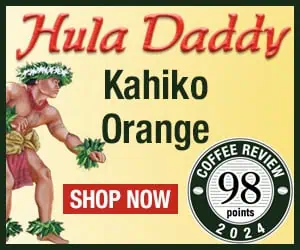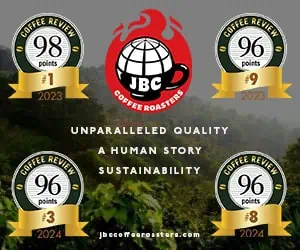Twenty years ago the line was clear between specialty coffees and “commercial” coffees. Specialty coffees were sold whole-bean, freshly roasted, in stores that offered their customers a wide range of choice in roast style and origin. Commercial coffees were represented by the almost identical contents of cans lined up like fat little percolator-ready soldiers on supermarket shelves.
Obviously, the line between specialty and commercial has blurred. Or at least the big players like Nestle, Procter & Gamble and Kraft Foods hope it has blurred, as they busily introduce blends that attempt to claim for themselves some of the panache of the specialty world. Folgers’ “Coffee House French Roast” even describes itself in French on one side of the can (for those who can’t read English?). Meanwhile, from the specialty side of the fence, Starbucks has descended onto the supermarket aisles with a line of — what? Specialty coffees? Cross-over coffees? Commercial coffee in specialty bags? Finally, supermarket chains have developed their own lines of packaged whole-bean coffees that aspire to the quality and variety of good specialty menus.
What is the quality-oriented coffee drinker to make of all of this? If this cupping is any indication, not much, although a couple of moderately pleasant tunes did warble plaintively above the hum of mediocrity.
Let’s start with the genuine budget coffees, those that cost (when we bought them in early December of 1999) less than five dollars per pound, or thirty cents per ounce.
The two standard medium-roast canned blends I sampled (Folgers Aroma Roasted and Chock Full’O Nuts) were listless and bitter, though pleasantly heavy-bodied. Both clearly contained a good deal of robusta, the inexpensive, full-bodied but tasteless coffee species that provides most of the filler for cheap blends.
Eight O’Clock Bean Coffee apparently took a different approach to cutting costs: Rather than clean but tasteless robustas, the blender used cheap, low-grade arabica coffees. The bold red bag of this venerable carry-over from the early days of A&P markets was filled with dramatically off-tasting, low-grade arabica coffees. Nevertheless, I found myself almost welcoming the hard, musty taste of this blend — at least I knew I was tasting something real, from the earth and from this world.
By comparison the canned “French roast” blends introduced by the three major commercial coffee players (Kraft Foods’ Maxwell House, Procter & Gamble’s Folgers, Sara Lee’s Hills Bros.) were exercises in emptiness, in which a fancy name and a slightly darker roast style covered a literal lack of flavor of any kind, good or bad. Given the bitterness of their medium-roasted blends, perhaps the big-three blenders felt that a more attractive option would be to offer the coffee drinker no flavor whatsoever. (By the way, I am not being snobbish or hyperbolic here, but factual and precise. About all the three canned French roasts did to hot water was turn it brown and add a vague weight and sweetness to it.)
For those lovers of the intense, pungent, near-burned coffees typically sold by specialty stores under the title French roast, two bargain supermarket versions did turn up. One, the Eight O’Clock Bean Coffee Dark Roast, was strikingly inexpensive at 23 cents an ounce but as decent a version of the extreme dark-roast profile as many specialty French roasts that sell for twice as much. The same low-grade, musty coffees may inhabit this bag as fill the red bags of the medium-roast “original” Eight O’Clock Bean Coffee reviewed earlier, but aggressive dark-roasting does wonders for low-grade Indonesia coffees, as many a specialty roaster knows. At 32 cents per ounce, the Trader Joe’s French Roast was more expensive than the Eight O’Clock Bean Dark Roast but even more intense in its bittersweet expression.
The champions of the under-thirty-cents-an-ounce coffees, at ratings of 81 and 83 respectively, were a 100% Colombia from Folgers (the best of three 100% Colombias I sampled) and the Hawaiian Blend from MJB. The Colombian Coffee Federation’s continued ability to put out a coffee with some genuine character and quality at prices low enough to support a retail price of thirty cents an ounce remains a sort of coffee miracle. As for the Hawaiian blend, it surely does not contain any Kona coffee, but in part may owe its quality to low-key but pleasant coffee from the island of Kauai.
The Starbucks House Blend, the Nescafé House Blend, and the Buena Vista Breakfast Blend represent a significant step up in price. They cost between fifty cents (Buena Vista) and seventy cents (Nescafé House Blend) per ounce and in roast style are darker than the standard American medium roast but not so dark as to dominate the coffee with roast taste. Of the three, the Starbucks proved to be a depressing coffee expression, bitter and heavily flat. The Nescafé and Buena Vista (a brand of Jewel/Osco) were decent moderately dark-roast blends, although I fail to see why anyone would choose to pay over eleven dollars per pound for the Nescafe, for example, a pleasant if pedestrian blend, when the same money would buy a much better coffee from a good specialty roaster.
The only real standout our supermarket buying spree produced was the Trader Joe’s Moka Java Blend. Trader Joe’s is a no-nonsense gourmet foods discounter with stores in eleven states Over the years I have found Trader Joe’s coffees always good values, though occasionally uneven in quality. However, this entry is excellent: a buoyant, elegantly clean variation on the traditional Moka Java formula. The Mocha component of the blend, in this case from Ethiopia, contributes delicate floral top notes and a bit of fruit. The Java fills out the center with modest richness.
Ultimately, this month’s cupping is about price. On the basis of taste alone I find it difficult to believe that anyone could possibly prefer the bitter emptiness of the two medium-roasted canned coffees or the flavor vacuum of the three canned French roasts to almost any offering, no matter how inept, from a specialty roaster. On the other hand, the Nescafé House Blend seems dramatically overpriced at seventy cents an ounce, given how much genuine quality that money would buy in a proper specialty store. The dull, heavy-handed Starbucks House Blend seemed overpriced as well, particularly when compared to the usually much better coffees sold in Starbucks retail stores.
At about the time I wrote this story Nestle sold its Hills Bros. and MJB ground coffee business to Sara Lee in order to “concentrate” (as they say in the business press) on the overpriced faux specialty Nescafé line. The lesson here seems obvious: Why battle for pennies in the price-driven canned coffee arena when you can sell a blend that purports to be specialty at a much higher margin?
I only can hope that consumers will not simply move on up the supermarket shelf from tasteless canned blends to somewhat better but overpriced offerings like the Nescafé and Starbucks, but instead will take make a short detour to someplace that carries coffees from roasters who genuinely value coffee character and quality.










